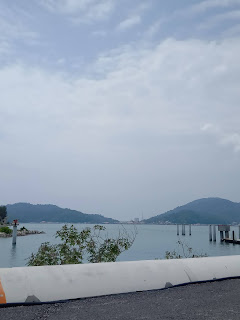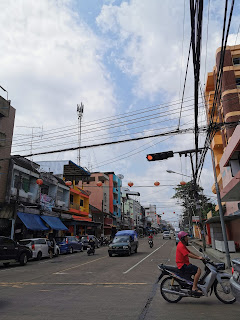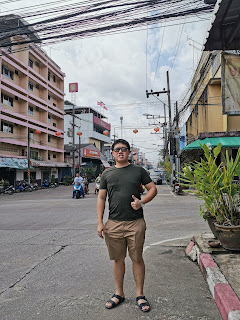In the
last day of my trip (6/2), I headed to ferry in a bid to return to Mainland
(lumut) of Peninsula Malaysia after having my last breakfast on the island.
That time, upon arriving to Lumut ferry, I still had a plenty of time to walk
around in the nearby Sitiawan town. Therefore, I asked my friend who is living
nearby that area to pick me up to have a half day tour there. Let’s begin with
half day tour series of Sitiawan…
Sitiawan,
Sitiawan is the main city in Manjung district of Perak state. Here is a brief
history, Sitiawan, Lumut, Ayer Hitam and Pangkor was part of Dinding straits
colony under the British rule since 1874. These places were relinquished back
to Perak state in the early 1930s after the cost of operation of Dinding
Straits Settlement was increasing tremendously year by year, yet another
Straits settlement such as Penang and Singapore were more successful than in
Dinding.
Things to do in Sitiawan:
Buy some freshly baked Foochow Gong
Piang
Sitiawan
and Pangkor are mostly resided by Foochow variety of Chinese also known as
(Hokchiu people). Foochow delicacy obviously included with Gong Piang. It is
made of meat, flour and occasionally with eggs and vegetables. There are the
small and big one variety of Gong Piang, in which both of them cost RM1.10 and
RM2.00 per pieces respectively.
Visit Tua Pek Gong Chinese temple
of Pasir Panjang nearby Sitiawan
This
Chinese temple is one of the largest and well-known temples in Manjung District
of Perak state. It is surrounded by the brick walls which are making it to be
appear as a temple within a castle. Meanwhile, according to some local source,
it said that temple itself has the reflection of wealth and having many
deities’ statues as well as temple ornaments owing to the donation from fellow
lottery winners whom they prayed for their lucky numbers there. For an example,
the Chinese temple authority recently has built a pagoda as a commemoration of
those donators who had contributed much fund to the temple, there are many
names were written on the board along with the mini deities’ statuses as a
symbol of their contribution.
 |
| View of the sea from the top of Pagoda. |
Besides,
I found a special worship place there – Yue Lao (月老). This
deity was worshiped by those singles persons in a bid of seeking another
partner as their soulmate in life. Since I am single man for many years,
therefore I chose to make use of that opportunity to pray for the deity hoping
that I could quickly to have a girlfriend. Frankly, this is just an act of
hoping the god to give me some luck and strength to find a partner, even though
I think it was not easy to do so.
 |
| Yue Lao Shrine |
Apart
from that, there’s also has a fortune dragon platform which is looks alike like
what is in Yong Peng for us to have a look. In the interior of the fortune
dragon, there are as series of pictures which are depicting the live in the
hell. According to Chinese Myths, the hell consists of a total 18 floors, in which the “higher floor” you go, it reflects the heavier sins that you had
committed in the real world. Thus, this fortune dragon is acts as an warning
for us to refrain from committing crimes or sins as these acts will be pay off
in the hell, once we stepped into the afterlife.
 |
| Hell... |
Mangrove forest reserve park
This part
I only could talk briefly as this mangrove forest reserve park is built in a
smaller scale as compared to the other ones such as in Kuala Sepetang.
Basically, the park is just having a wooden-made walking track for the visitors
to have a look on those mangrove trees in a nearer distance. Besides, you may
have a chance to meet a group of monkeys there jumping from a tree to the
another one as well as some tiny crab that crawling in the mud under the
walking track.
Visit Kampung Koh
Basically,
Kampung Koh is just a regular Chinese rural settlement nearby Sitiawan main
town. However, there’s a local product which made the village itself to be famous
among the visitors, which is Kampung Koh Garlic Chilli Sauce. This chilli sauce
is selling across Sitiawan with a generic brand of product as there are too many
producers who produces almost similar type of garlic chilli sauce. In fact, the
original producer is NKL’s brand in Sitiawan. According to the Star newspaper article, Kampung Koh chilli sauce was first produced by the Ngo’s family, which
they are the ones who invented the ingredient of recipes for the chili sauce. Nonetheless,
as the time passes, there more and more almost similar product competing with this
NKL’s garlic sauce in the market of Malaysia, let alone the original
manufacturing place – Sitiawan. Therefore, Kampung Koh is associated to its
local product of Garlic Chilli Sauce but this sauce has been becoming too
generic as the real owner’s recipes could be made by the other rival chilli
sauce manufacturers there.
 |
| Gong Piang |
 |
| Red bean soup sold at Kampung Koh |
 |
| Kampung Koh chilli sauce |
Last but not least, Marina
Island.
It is a
man-made island in Lumut, Perak. The island was opened to public by 2015 and it
is apparently nearer to Pangkor Island as compared to from Lumut ferry. The time
of travelling from there to Pangkor is merely 15 minutes as compared to from
Lumut.
 |
| View of Pangkor island from Marina island. |
After
visiting all these places in Sitiawan and Lumut areas, my trip has called an
end. From this trip, I got to know that Pangkor island is a mini version of Langkawi
Island as the island has also been classified as duty-free zone and
there has a completely tarred ring road on the island which makes all the
vehicles being able to be use on the road. The only different thing is that
Pangkor has lesser in the number of cars as the roads there are quite narrow
and challenging to drive and duty to be imposed on any cars that bring from the
mainland of Peninsula Malaysia. Unfortunately, I didn’t make it my way to outlying
islands of Pangkor as island hopping cost was way to expensive than travelling
within the main island. The next time I might travel to the outlying islands of
Pangkor as well if I manage to travel here again in the future.
Alright,
the end. Thanks for reading this series of blog posts, be sure to subscribe to
me on my blog website too. Peace.

























































